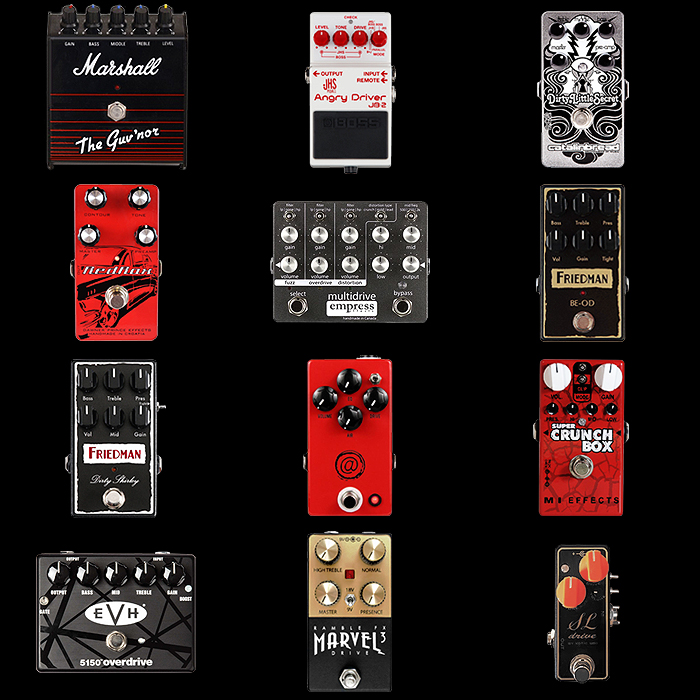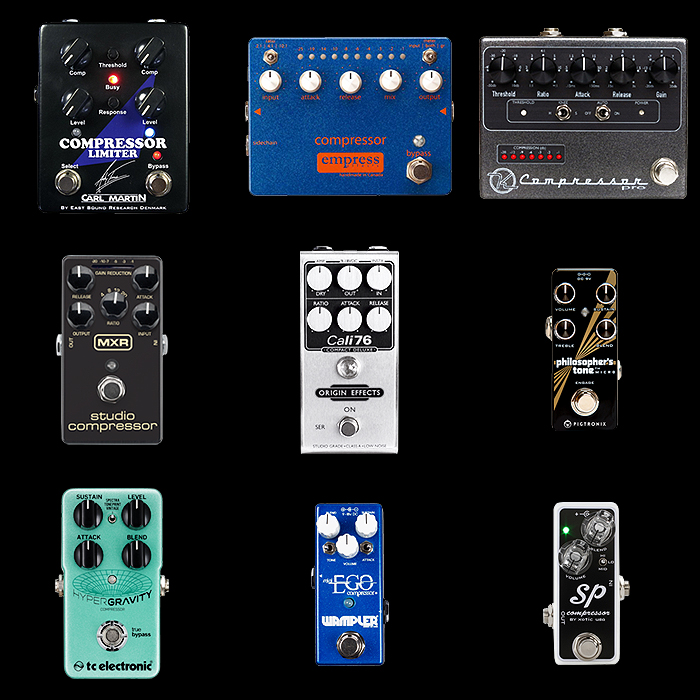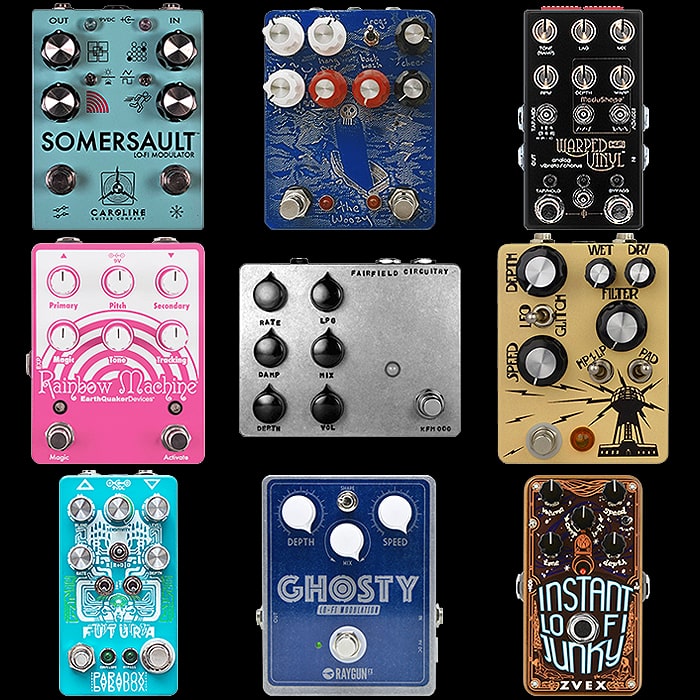Singular Dominant Pedal Colour Association by Guitar Pedal Type / Genre

This article was obviously triggered by this last Friday’s The JHS Show episode (as referenced below) - where Josh Scott and Nick White discussed Pedal Colour Theory - and which colour/s were most obviously associated with a particular effect type. Those two gentlemen discussed 6 varieties and I’ve expandanded the categories to 12 - for a more definitive take on the subject.
I’m of course no newbie to Colour Theory having an extensive background in Brand Strategy and Consumer Behaviour - and for which of course colour-choice is a key influential element.
I wrote a colour theory article some years ago as part of my day job - ’The Science of Brand Colours’ which explains the symbolic, cultural and emotional relevance and resonance of specific colours. For Guitar Effects Pedals - a couple of the early companies involved in the industry really set the bar for producing colour-specific / colour-coded effects variants - and their early compact pedal ranges have had an overwhelming influence on the industry ever since.
In fact I would say that Boss really kicked things off majorly in 1980 with the launch of its celebrated Series 2 range in circa 1978, while MXR’s earliest compact date back to 1972 (Dyna Comp). Funnily Boss’s original 3 1977 colours did not go on to dominate those colour-associations - while the Yellow OD-1 was in for a shout - while as we will see though that the Dominant Green and Red colourway variants turned out to be outside of the Boss range / universe. Boss’ overall formula was that strong though that 6 of my selections here are Boss Series 2 originals - while there are a number of other Boss pedals that kind of contest some of the categories - but really if you hear someone say ’That Green Pedal’ the first associations is always going to be TS808 rather then PH-1 for the vast majority!
The last time I did this sort of exercise - ’The Pedal Primary Colour Wheel’ (as below) I started the exercise the other way around - looking at a colour-chart as the starting point and deciding which pedals essentially ’owned’ and dominated that particular colour or hue. In fact there is some significant degree of overlap with my previous exercise / work - while there are of course some differences too as the criteria are rather more specific this time around. Also, as opposed to Josh who went green and orange for several associative choices, I obviously strictly limited each pedal genre to single colour association - so strongest / most dominant colour only and no equivalency or near matches - I will obviously discuss the other relevant candidates, references and collateral for each selection made. But you can only have each of those colours apply once - you can have say Orange for both Distortion and Phaser - you need to choose for which effect type that colour is specifically dominant!

We can see that there are some definite overlaps between the two exercises - with Boss and MXR, but Ibanez here also being among the dominant brands. We also have the unusual duality that the colour Red is represented by the most obvious of choices - the MXR Dyna Comp, while Diamond Effects' Compressor Jr is also a very well known / associated Compressor colour choice - as can be seen by the Mooer Pale Yellow Compressor. I do feel though that the Dyna Comp is the more iconic of the two - as we shall see below. Everything on that chart is pretty obvious and self evident - it's just the frame of reference or perspective that is different - as here we are projecting out from the colour chart as the principal stimulus, while in the new exercise the principal stimulus is the individual pedal categories which we then find the most relevant colour for.
Here below is the celebrated JHS Show YouTube video then with heaps of comments on viewers' own choices / selections - and I'm heartened to see many there that are in broad agreement with my own very scientific results - for which I will endeavour to provide the full evidence and rationale below :
As mentioned - and per the above - Josh and Nick cover half a dozen categories - Distortion, Phaser, Delay, Fuzz, Compressor and Chorus. And while Joss has one foot in the heritage and provenance of the pedals in general - Nick makes some rather bizarre choices for some categories - but some equally inspired ones for others. Obviously there is a slight JHS bias here to a degree - with is best manifested by the choice of the JHS Pulp "N Peel Orange Squeezer Compressor - based on the Dan Armstrong original. I think most pedal pros would single out rather Red (MXR Dyna Comp) or Yellow (Diamond Compressor) as being the more obviously associated pedal colours for this genre. There is quite a bit of wisdom in some of what is said - while there is also something of an absence of proper scientific method and discipline!
#1 : Boost - LIGHT GREY / SILVER / RAW METAL

So Boost is one of the categories I added to the list - and I started to consider the heritage and provenance of Boosters in general. One of the earliest boosters was of course the 1966 Dallas Rangemaster Treble Booster - which came variously in white, raw steel or sort of hammerite enclosure - with probably the latter hue more iconic - and which has been reflected in most of the more recent replicas and reproductions.
And while the Rangemaster was the first Boost pedal as such - it is somewhat still a more specialist choice - and I feel though that the Electro-Harmonix LPB Linear Bower Booster is more universal in its relevance and appeal. Which is hence why I chose the original polished steel LPB-2 as my poster-child and ambassador for the Boost genre. In the attached boost roundup pics - you can also see that silver / grey / raw metal is still the most dominant colourway!

You can clearly see that in my two most substantial Boost roundup features that the light grey / silver / raw metal colourway pedals tend to be the most common examples. In fact based on the median values of the above you would have to say that Light Grey and White - or the original Rangemaster colours are the ones that mostly hold sway.
I more readily associate White with another genre type - q.v. - so extrapolating from the Rangemaster and LPB - the Light Grey / Silver has to be the most suitable choice here.
#2 : Overdrive - GREEN

This is probably the simplest and least controversial category, You could ague that we have two suitable colour candidates here - Tube Screamer / 808 Green and Boss OD OverDrive Yellow. If you think on it for a split second though - there is nothing more ubiquitous than the green pedal or green overdrive pedal - every single person knows exactly what that is - and we can see that in the proliferation of how many brands use Green to represent their overdrive variety.
The TubeScreamer is the most replicated of all pedal designs - near enough every brand has its own version of one - and in well over half of those cases - the replicas, derivations and variants tend to be in shades of Green!

Boss obviously comes in strong with its own Yellow OverDrive OD series which started with the OD-1 back in 1977, Yet by and large Boss has been alone with the Yellow colour representing Overdrive - while there is of course T-Rex's Mudhoney (Rat variant really) - as in my Pedal Primary Colour Wheel visual above. Yet we also have the MXR Distortion+ and the Diamond Compressor - which is what Mooer has as its Yellow colourway mini pedal of choice.
I feel that the proliferation and ubiquity of the Ibanez Tube Screamer is such - that you could not in good conscience give the win to any other colour but Green! It is by far and away the most common colour for Overdrive.
#3 : Fuzz - PURPLE

Fuzz is a more oblique and abstract category in many ways - and thinking of the early Fuzz colour variants it would be hard to draw any median value conclusion. The very first Fuzz - in fact the very first guitar pedal ever was the sort of wedge-shaped Black-enclosured Gibson Maestro FZ-1 Fuzz-Tone. Then we had the gold and silver/grey Tone Benders, and then Red and Blue Dalas Arbiter Fuzz Faces - which also had later grey variants.
Boss obviously chose Grey as their Fuzz colour of choice - and there is much that can be said in support of that candidate. But I come at it from a more cultural perspective on this occasion.
For me - my key association with Fuzz is still Jimi Hendrix and the Psychedelic Music Movement of the 60's and 70's - where my most obvious cultural reference is the term 'Purple Haze'. Purple being a dominant colour for both Hendrix, the artform and artworks of those days of Psychedelia. And while Purple fuzz pedals did not really take significant hold until somewhat later - I most associate the colour Purple with fuzz - and for which the most obvious poster child is the still much sought-after KR Musical Products The Gypsy Fuzz - which I have a Basic Audio version of funnily enough - but not in that same very apt colourway!

In my original Fuzz pedal / Fuzz ToneQuest roundup - when I had but 40 of those in my collection - you could argue that there really isn't any massively dominant colourway - while the greys probably have it as the single most repeated tone for that selection. As my fuzz collection is now up to 220+ it's only really the huge variety of colours that is the visible pattern. Much like the early roots of the fuzz pedals had various different colour-associations - the Fuzz category overall is quite open and still features a veritable rainbow of colours - including all those earliest variants..
I think there is a strong argument for Grey here also - while I feel generally that Grey sits better with the consistent Rangemaster and LPB colourway - and that the most associated colour with Fuzz and its larger Psychedelia social movement - has to be the colour Purple!
This is one category though that is open lot a ot of debate - and I can concede Grey in some ways - while that is the only colour for me that ideally matches the Boost category. So some contention here - but Purple for the win!
As a postscript to this I will throw another spanner into the works - as when I did my original Pedal Colour Wheel article - I argued that the one pedal what was most singularly associated with the Colour Purple was Lovepedal's Purple Plexi. Yet as a whole category, genre and movement - you would have to be somewhat churlish to vote against the very culturally significant Purple hue for Fuzz overall.
#4 : Distortion - BLACK
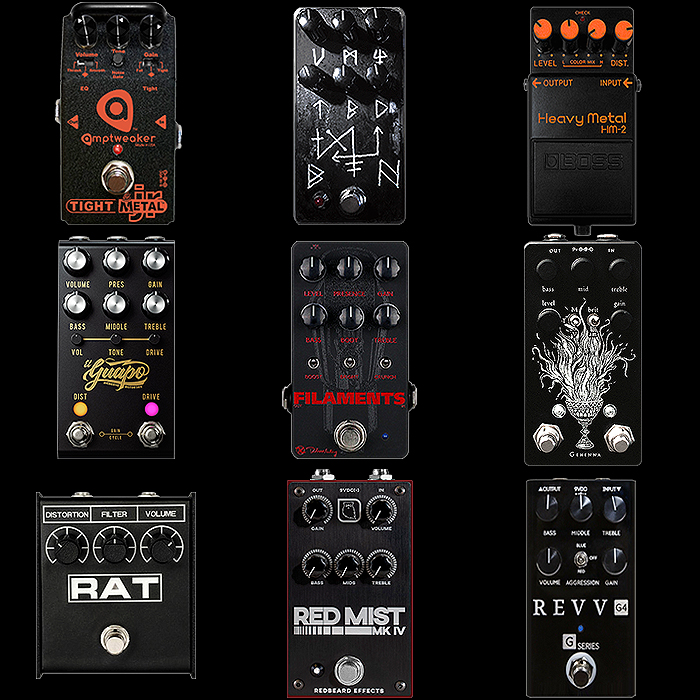
For this interesting category we vaguely have 4 significant Colour candidates for consideration. The very first distortion pedal as such was Boss's Orange DS-1 from early 1978, then the earliest Black bigger box ProCo Rat later in 1978 and finally MXR's Yellow Distortion+ from 1979. Latterly we also have had quite a heavy proliferation of Red Marshall-style distortion pedals which are still very prevalent at the moment - weirdly considering that the colours generally most associated with Marshall are Gold and Black!
I will tackle each colour in sequence and explain how I arrived at my final conclusion. And we shall start with the Boss DS-1 and MXR Distortion+. In fact Boss was challenged from the start here really as the MXR Phase 90 had already commanded the public's attention back in 1974 when launched - so there was already a very healthy association between Orange and Phaser before Boss introduced its Orange Distortion variant.
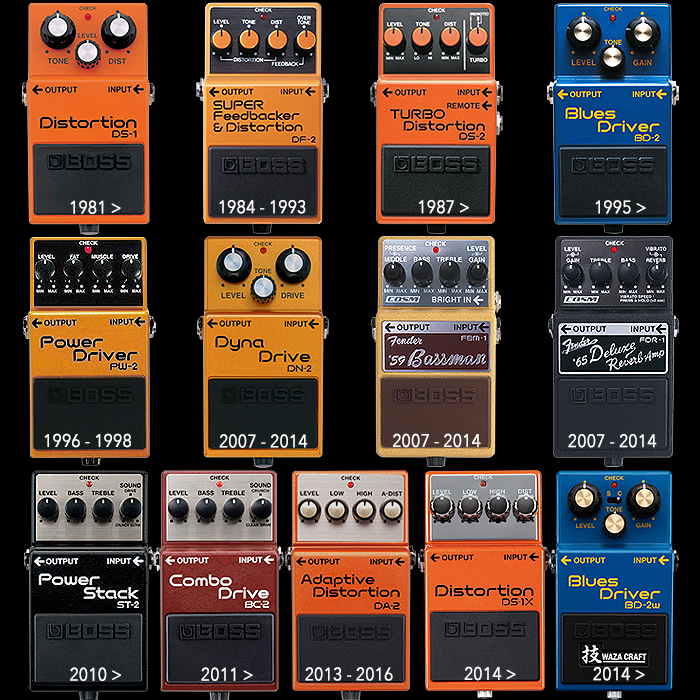
And while Boss rolled out a number of derivations and variations of Distortions in Orange - it was largely the only brand that pursued this avenue. Same could largely be said about MXR's Yellow Distortion+ - which as an associated colour really failed to find much transaction in the Distortion genre bar perhaps JHS's Charlie Brown and latter-day Yellow variant of DOD 250 - which most still associate with its original Grey colour. Oh and of course T-Rex's Mudhoney Distortion - which is a slightly more honeyed or amber hue of Yellow.
Generally Orange and Yellow were exceptions to the rule in representing Distortion pedals - and can be dismissed relatively easily - they just did not gain enough traction among other pedal-builders to become the mainstay representative colour for this genre!
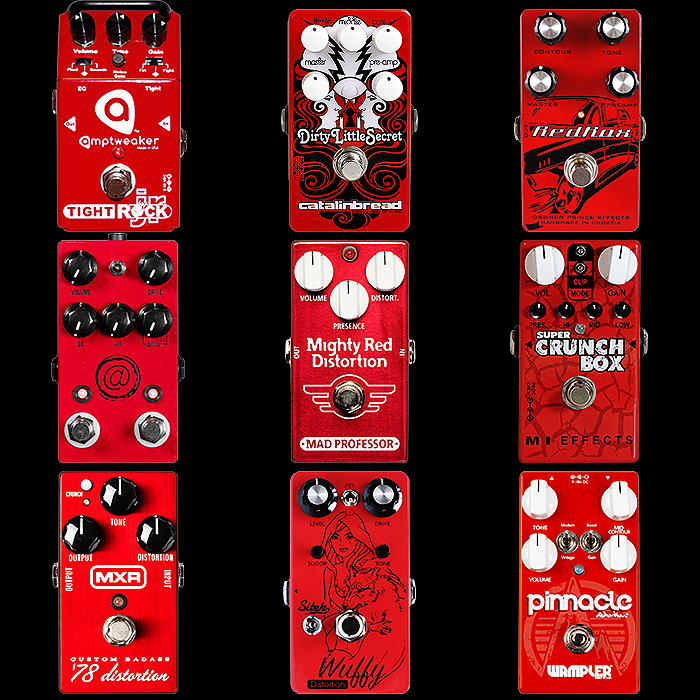
The 4th significant colour candidate here is a much later development and I believe has much to do with the success of MI Effects' original Crunch box which was introduced in the early 2000's. This is also Mooer's chosen red Mini variety - the Cruncher - which is a good sign as to the impact of said variant and its colour.
So there are currently a whole load of Marshall-style drives and distortions per the above visual that make use of this colour. While red had really already been captured by MXR back in 1972 with the release of its now ubiquitous Dyna Comp Compressor. You would have to say that on balance Red really belongs to the Dyna Comp Compressor and derivatives / inspirations. Yellow is arguable a Compressor too - courtesy of Canada\s Diamond Compressor - which Mooer also references in its chosen mini Compressor candidate.
Orange was taken by the MXR Phase 90 back in 1974 - long before the Boss DS-1 materialised - which while that's sill an iconic pedal nowadays and of course also associated with Orange - I still feel very strongly that Orange is very largely owned by the Phaser category - which we shall see when we come to that.
In the reanimate therefore Black has to be the most singularly strongest candidate for Distortion - since the popularity of the ProCo Rat - and particularly since 1984 when it evolved into its more compact current Rat 2 format.
Black is wholly synonymous with the Metal / Extreme Distortion Category, it's also synonymous with Marshall as one of that brand's dominant colours alongside Gold. You see a Black pedal - and your most likely thought is that it's a Distortion - while the other Colour considerations here have generally broader applications.
It's definitive then really - Black is most definitely the right choice here.
As a postscript to this I have to say also that Black and White are quite generic pedal colours to a degree too and applied liberally across all genres and brands. While the strongest overall association with Black has to be Distortion really.
#5 : Chorus - SKY BLUE / CYAN

This category for sure is a shoe-in - as ably demonstrated courtesy of the above highly suitable visual, and the more recent 28 strong roundup per the below picture.The hue has changed somewhat more towards the brighter Cyan tone more latterly - while the original Boss 1979 CE-2 Chorus was a rather paler and more subtle Sky Blue hue.
There is no other conceivably strong candidate really for this category - such is the proliferation of the Sky Blue shade for this genre that it significantly overwhelms all other candidates and pretenders.
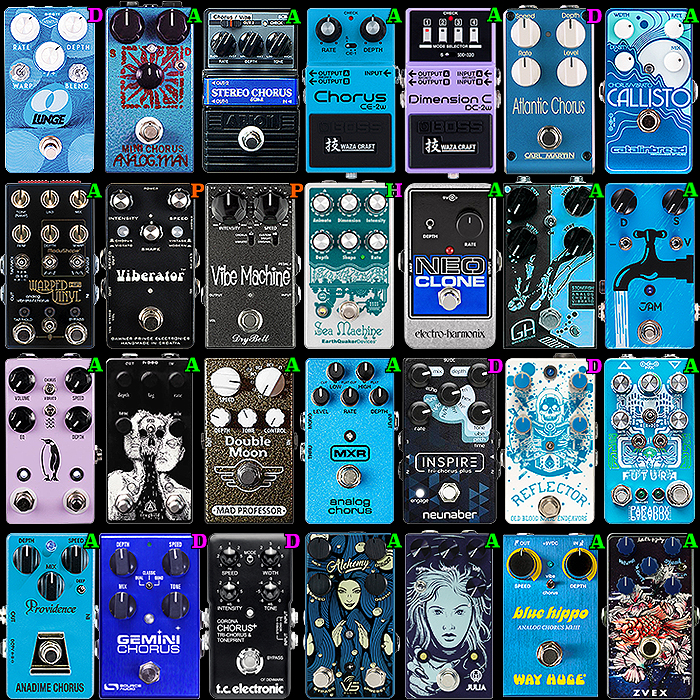
My recent larger 28-strong roundup still ably demonstrates the Sky Blue dominance here of all the different colourways. There is a smattering of other hues - a few back and dark grey pedals in particular, but the most popular colour here for sure is Sky Blue - no contest!
There's just a tiny splinter group here too with Boss's DC-2 and JHS's Emperor chasing Lavender - so fairly evident where Josh took his influence from on that occasion.
#6 : Flanger - MAGENTA / GRAPE

This is actually one of the more contested / contentious categories as you could argue that Electro-Harmonix's original 1976 Electric Mistress Flanger kind of set the scene with its Green typography - which was then later incorporated as a more solid Green colour block on latter editions. Yet relatively few other brands really took to the Green colour - and in fact many more copied Boss's 1980 BF-2 Magenta / Grape colourway. While Green became ubiquitously associated with the 808 Tube Screamer Overdrive instead.
You can see the Magenta / Grape hue resonate with Foxrox's Paradox Flanger, Strymon's Ørbit Flanger and TC Electronic's Vortex Flanger in particular amongst others.

In the wake of the Buffalo FX Reticon Flanger saga - I have still to complete a more in-depth review on the most suitable medium-enclosure Flanger candidates - where you can see the dominance of Magenta / Grape over Green in particular.
I feel that on balance the evidence and collateral is sufficiently strong to come out in support of Magenta / Grape as being the more natural and obvious colorway choice for Flanger overall.
#7 : Phaser - ORANGE

This is another category which is realistically wholly dominated by a single colourway. You can argue to the tiniest degree that the Green of the BOSS PH-1 is a valid and relevant choice - while when you examine the evidence this is quickly disproved.
Green is much more naturally and commonly associated with the Overdrive / Tube Screamer genre - while the Orange tone still significantly dominates the Phaser category - since MRX's Phase 90 arrival back in 1974 - three years before the PH-1.
You can also see in my recent 28-strong roundup that the orange colour is still the most significantly dominant colourway :

I could have included a few more of my formerly selected Orange variant phasers to more significantly underline the Orange colour dominance - but there's no need really - such is its very evident visible dominance. There is generally a fairly wide spectrum of colourways here - but one is very much more prevalent - and the other odd pair of Greens and Purples - which are outliers really beyond the best-fit line.
No contest here that Orange is the colour for the Phaser genre.
#8 : Tremolo - TEAL

This is one of those much more open-ended categories where we really don't per se have a majorly overwhelmingly dominant Colourway either historic or heritage -wise - but rather largely a plethoras of quite broad and colourful executions. I have though fallen back on one of the trusty but latterday Boss Series 2 candidates - the Teal coloured TR-2 initially introduced back in 1997 that is to say.
I feel that its colour is a somewhat inspiration for the Tremotron, Jack Rabbit and Supro - and lesser degree the more surf-green/ min-green of the Pipeline. There is some very slight resonance in that Teal colour which is distinctly unique enough a shade to represent a category.
In looking back at all my various Tremolo roundups - Harmonic, Mini, Compact and otherwise there is really no other single colour up to the task.
This is nothing like the proliferations of the Sky Blue for Chorus, Magenta / Grape for Flanger or Orange for Phaser. But it is a singular signature colour that you can pin a category to - and in the absence of any other significant pattern here - then Teal is my most obvious candidate for Tremolo!

You can see in my Harmonic Tremolo roundup that there is no single dominant colourway represented there at all. In fact you could pronounce it fully diverse and inconclusive as a proper scientific experiment.
Yet if you are slightly more lenient and circumspect within the 28-strong roundup you can kinda sorta extrapolate and best-fit the curve to substantiate Teal as being the most suitable representative candidate here.
While in truth really the whole category is still rather open-ended.
#9 : Compressor - Red

This category starts off somewhat ironically in that I've never included the original / simple variety Red MXR Dyna Comp Compressor in one of my Compressor category roundups. While it's obviously centrally featured in my two top Colour Reference Visuals - and has been a very significant industry influence since its arrival in 1972.
I still contend that the MXR Dyna Comp Red 'Owns' the Compressor category - even though I've yet to reference it in an overview. Instead we can see its influence in the colourway of the Foxpedal Refinery Compressor, JAM Pedals Dyna-SSOR, accent colour of Walrus Audio Deep Six, and recent Strymon Compadre Compressor + Boost. Also BBE VC-3080, BMF Effects Little Red Compressor, DOD 280, Ibanez CP9 and Maxon SE475 - to mention a few.
So there's an adequate proliferation of Red colourway compressors in the category - even though that particular colour does not stand out in my own specific Compressor pedal preferences - per my most recent 28-strong roundup below :

Truth is that for most of my pedals I like a little more flexibility and versatility - which is usually very hard to come by with just two knobs. For Studio-style compression there are a lot of parameters I like to exercise control over - and do slightly more clever things that the simplest examples cannot.
That doesn't mean I'm opposed to simplicity - there are times in fact when I really relish and value single and twin-knobbed pedals. For Compressors though my taste certainly gravitates towards the more complex - which overlooks many of these simpler examples - where though I have included several now in the above 9 Red Compressor visual - composed fort this very article.
#10 : Octaver - BROWN / CHOCOLATE

This is another intriguing category with a somewhat unusual colour selection. I've gone back to Boss's Series 2 again for 1982's Brown OC-2 Octaver pedal. I am only aware of a handful of brown pedals - having the Mad Professor #1 and Simble in my collection as well as the MXR Brown Acid Fuzz, OneControl Anodized Brown Distortion, TC Electronic's MojoMojo Overdrive and Xvive's Golden Brownie Distortion. I also recall Cornerstone's Antique Overdrive, Lovetone's Brown Source, Nux's Roctary and Zvex's Vertical '59 Sound to name a few more.
Out of all of those It's the Boss OC-2 that stands out as the clear poster-child for Brown - as is also reflected by Mooer's Mini Pure Octave variant of the same. Red also has some influence on this category as the EHX POG is traditionally red, while it's PitchFork has a red accent.
Overall though I feel that Brown or Chocolate is the right shade for Octave - and in particular sort of metaphorical of a Sub-Octave! I initially only recalled a handful of Brown pedals - but there's quite a few more of those than I first remembered - including the whole of the EVH-style Brown Sound distortion category. Still a worthy colour choice here overall though!
#11 : Delay - WHITE

Delay is another pretty clear category fortunately quite literally - and once again we call upon yet another Boss Series 2 candidate - the original world's first DD-2 Digital Delay pedal from 1983. White is quite a good metaphor for Delay and Echo - in representing the great white expanse of our atmosphere.
Lots of other brands have taken heed of Boss's lead here - and we have a huge number of white delay pedals - including a bunch of very new ones per the above visual.
In looking across the spectrum of delay pedals I cannot think of any other colour or tone which so well represents this category. For analog delay you have Boss's Red DM-2 vying against MXR's Dark Green Carbon Copy - of those probably the Dark Green comes out the winner.
For Digital Delay though the winner is clean pristine White!
#12 : Reverb - DARK GREY

So for the final category for this selection - we're back to a more complex conundrum where there is not that distinct a clear leader - and where in fact the landscape of Reverb pedal colours is fairly fractured and diverse. I quite like the idea of Strymon's BlueSky and BigSky reverbs - while that colour is already taken by Chorus. You could argue that Chorus is more watery - and should be more of a deeper ocean blue - while Reverb should be more of a Sky Blue. Yet first mover advantage is such that you get to define what follows. Meris' Mercury 7 Reverb sits somewhere between an Ocean Blue and Sky Blue (actually probably more ocean), while Mooer's Ocean Machine is definitely that Deeper Darker Ocean Blue.
If I had my way - Chorus would be Darker Ocean Blue and Reverb would be the Lighter Sky Blue - yet those colours are already taken! In fact if you look at the entire Reverb category - the dominant shades tend to be Grey, Blue and Black. You could also argue the difference between the shallower water blues - which are closer in hue to Sky Blue - where deeper ocean is always going to be significantly darker.
So it's still kind of associatively odd in some ways that Boss settled on Dark Grey for 1987's RV-2. That colour though has found a few adherents such as the Joyo Atmosphere, Mooer Mini ShimVerb, Source Audio True Spring and Ventris . It's funny too that Boss's MT-2 Metal Zone is mostly the same hue - just with bright orange text to distinguish it. Yet when Mooer reinforces the colour choice with a Mini replica of its own in that hue - then it's a fair shout to proclaim Dark Grey as the most appropriate representation fo the Reverb pedal category!
Final Thoughts


It's funny that I thought this would be a quick knockabout article to compose - while it's taken the best part of a day to compile!
I was fortunate that I'd already covered a lot of ground before in the following referenced articles:
- Pedal Primary Colour Wheel
- Boss 40 Shades of Tone
- 9 x Blue Means Blues
- 9 x Green Means Scream
- 9 x Orange Means Phaser
- 9 x Purple Means Fuzz
- 9 x Red Means Marshall
- 9 x Sky Blue Means Chorus
- 9 x Yellow Means OverDrive
I composed the top Genre Colour Chart, 9 x Black Means Distortion, 9 x Red Means Compression, and 9 x White Means Delay visuals just for this article.
I think some of the associations are obvious and clear and beyond any major debate or quibble - particularly as is born out by several visual references of the same colourway per category. A few of these categories are less clearly defined and haven't really evolved a fully dominant pattern yet.
I do think this opens up a number of interesting questions about general pedal colour choices - and what has become the accepted norm despite there possibly being alternative preferable colour ways - as discussed in all of the above.
Of course I would be fascinated to hear your own properly rationalised selections and to see how much you agree or disagree with my own conclusions!
Generally though - if in doubt - just go back and check on the Boss Colour Chart from circa 1978 onwards!























